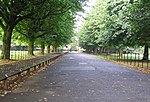Wythenshawe and Sale East (UK Parliament constituency)
Constituencies of the Parliament of the United Kingdom established in 1997Parliamentary constituencies in Greater ManchesterParliamentary constituencies in ManchesterPolitics of TraffordWythenshawe

Wythenshawe and Sale East is a parliamentary constituency in the city of Manchester and the borough of Trafford. It returns one Member of Parliament (MP) to the House of Commons of the Parliament of the United Kingdom, elected by the first past the post system. The constituency has always been a safe Labour seat, and the southern part of the constituency includes Manchester Airport. The current MP is Mike Kane of the Labour Party who was elected at the 2014 by-election in February 2014. He succeeded Labour's Paul Goggins who died in January 2014, and who had held the seat since its inception in 1997.
Excerpt from the Wikipedia article Wythenshawe and Sale East (UK Parliament constituency) (License: CC BY-SA 3.0, Authors, Images).Wythenshawe and Sale East (UK Parliament constituency)
Shevington Gardens, Manchester Northern Moor
Geographical coordinates (GPS) Address Nearby Places Show on map
Geographical coordinates (GPS)
| Latitude | Longitude |
|---|---|
| N 53.41 ° | E -2.27 ° |
Address
The Manchester College, Northenden Campus
Shevington Gardens
M23 0BJ Manchester, Northern Moor
England, United Kingdom
Open on Google Maps







